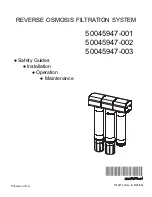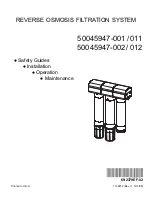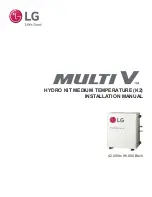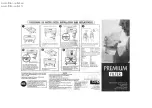
Installation and Service Manual – L Series Reverse Osmosis System
Systems and Components
Membranes
,
Filters
,
Chemicals
2325 Cousteau Ct., Vista, CA 92081 USA • www.appliedmembranes.com • E-mail: [email protected]
Page 26
Copyright © 2008 Applied Membranes, Inc. All Rights Reserved.
Shut-Down and Storage
Caution:
Handle all chemicals with care. Wear protective clothing and eye protection.
Membrane
Storage
(outside
of
RO
system)
To prevent bacterial growth and help maintain flux, it is recommended that elements be immersed in a solution 20.0
percent, by weight, AM-225 and 1.0 percent by weight AM-88.
Prepare the Solution:
Make a water solution by adding about 1 ounce of AM-88 per gallon of water (use RO permeate if
possible). Also add about 1.5 lbs of AM-225 per gallon of water.
Storing Elements:
Mix the solution well. Soak the elements in this solution for 1 hour. Drain and seal in plastic bags.
RO
System
Storage
and
Biocidal
Protection
To prevent biological growth during storage, shipping, or system shutdowns, it is recommended that RO systems and
membranes be immersed in a solution of AM-88. This can be performed using a membrane preservative cartridge,
part # C-C2520-A88.
System Preserving Procedure
1. Shut down to RO system.
2. Disconnect the permeate line and direct permeate to drain during cleaning/preserving.
3. Remove the 5M filter cartridge from the pre-filter housing.
4. Replace the filter cartridge with the preservative cartridge and assemble into the filter housing.
5. Turn system ON. After 30-40 seconds, shut down the system.
6. Drain the system of the permeate solution as much as possible by opening a valve/fitting at a low point in the system.
Close off the inlet and outlet to the membrane/system.
Flushing out Preservative/Re-start Procedure:
1. Open valves etc. and put the system back in the position it was before preserving.
2. Remove the empty preservative cartridge and replace it with a new cartridge filter.
3. Re-start the system. Direct permeate to drain for at least 30 minutes.
4. Return to normal operation.
Disinfection and Sterilization of RO Elements
An excellent disinfectant
for spiral elements is 0.1 percent
AM-88
. This solution inhibits bacterial growth while
maintaining the high flux and salt rejection of elements. It is made by dissolving one ounce of AM-88 in 8 gallons of water.
Elements should be flushed with this solution before storage or at the beginning of long down periods.
Sterilization can be achieved with formaldehyde.
However, this reagent should not be used unless the element is first
operated for 24 hours. Otherwise, severe flux losses may occur in the membrane. After this initial period, the membrane
will tolerate any customary formaldehyde concentration used in sterilization.
Other disinfectants and sterilants
can be used. Hydrogen peroxide at 100 to 1000 ppm (0.01 to 0.1 percent) is effective
at room temperature. Hydrogen peroxide will damage the membrane at higher temperatures, however. Chloramine,
Chloramines T and N chloroisocyanurates can be used in spiral elements. They are not very effective as sterilants,
however. Also, if they are used in combination with an already heavily fouled (biological) test loop or system, flux losses
are occasionally experienced from dead bacterial matter in the feed stream depositing on membrane surfaces. Chlorine
dioxide, free of hypochlorite or chlorine, may be used as a disinfectant. Both Chloramines and chlorine dioxide readily
pass through membranes, appearing in the permeate.
Chlorine
(hypochlorite) is not recommended for disinfecting membrane elements. Permanent damage will occur.
Iodine
, quaternary compounds, and phenolic disinfectants cannot be used with spiral elements. All three cause severe
flux losses.











































